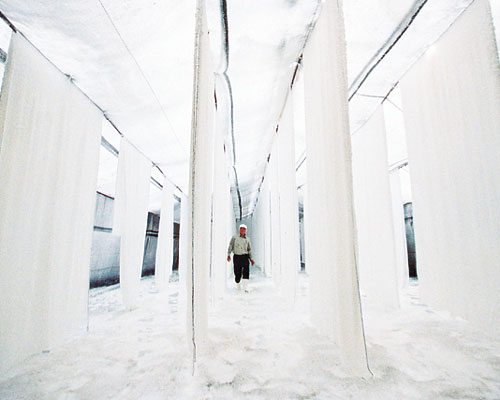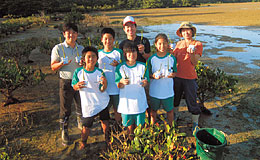Special Feature![]() Okinawa’s Beautiful Sea
Okinawa’s Beautiful Sea
Minerals from the ocean, nature’s salt
Takayasu Masakatsu, President of Nuchima’asu Co., Ltd.
Nozzles spray seawater out as a fine mist, as part of the company’s unique salt manufacturing process. The air inside the factory is a hot 50°C, and the salt and other minerals in the mist crystallize mid-air in an instant. The salt, called nuchima’asu, contains all of the major minerals in seawater.
“All life traces its roots back to the oceans. Seawater contains practically everything that is necessary to sustain life. So we call our salt ‘crystals of life,’” says Takayasu Masakatsu, the company president.
The manufacturing technique, which he developed, follows the “ambient temperature instantaneous mid-air crystallizing method.” Nuchima’asu Co., Ltd., takes its name from nuchima’asu, which means “the salt of life” in the Okinawa dialect.
Everything in the seawater that is crystallized becomes part of the salt, so of course he wants the purest water possible. That is why he chose Miyagi-shima, a small island connected to the eastern shore of the main island of Okinawa. Here the industry is fishing—no factory or farm operations to pollute the sea.
In 2000, the Guinness Book of World Records recognized nuchima’asu as a sea salt packing the best mineral content in the world.
Takayasu says he wants to see his salt distributed wherever people do not have enough essential minerals in their diet.
Saving their treasured mangrove forest
Students at Nago Municipal Yagachi Junior High
Years ago, a lush mangrove forest covered the tidal flats around Yagachi-jima (circumference, about 16 km), which is now connected to the Motobu Peninsula on northern Okinawa. The mangrove swamps were once home to mangrove trees like ohirugi and mehirugi, but after World War II many were removed to make way for sea walls to combat coastal erosion. The tidal flats behind Yagachi Junior High School luckily remain to this day, and even include the tallest ohirugi forest in Japan.
“Mangroves protect and nurture many life forms, so they are called ‘the cradle of marine life,’” explains Sakashita Hiroko, who is active in the forest conservation movement on northern Okinawa.
Leaves and seeds that drop from mangrove trees onto the tidal flats become food for crabs, fish and other creatures, and the tree roots create a habitat for many forms of life. And the vast expanses of tidal flats purify the seawater, when mangroves are present.
The school fostered a keen interest in local nature conservation, and since 1993 all of the students have been pitching in, planting 600 to 1,000 mangroves every year. All those trees—how does it feel to see them growing over the years? “Great!” ![]()


